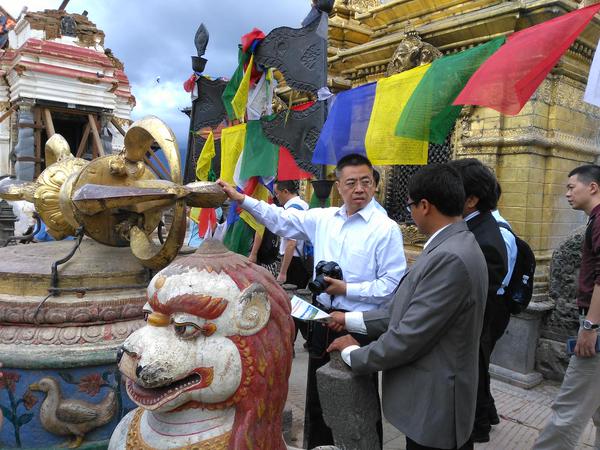Nepal Foreign Affairs (Kathmandu, July 22) : An 11-member Chinese delegation headed by Deputy Minister of Commerce of China Zhang Xiangchen visited the earthquake-hit Bashantapur Durbar Square on Wednesday.
The Chinese minister said that China wishes to extend support in restoring the earthquake-ravaged UN World heritage sites including the Bashantapur Durbar Square.
The delegation, which arrived in Nepal Tuesday also visited the Civil Hospital at Baneswor which was established with the support of the Chinese government.
The delegation was earlier received by senior officials of the Ministry of Finance. According to the Ministry of Foreign Affairs, the delegation will hold series of meetings with Nepali officials including Prime Minister Sushil Koirala on Nepal’s reconstruction and Chinese cooperation for the same.
This will be the first international delegation in Nepal to talk on Nepal’s reconstruction after Nepal hosted the successful International Conference on Nepal’s Reconstruction on June 25.
During the three-day visit, the Chinese delegation is scheduled to hold bilateral talks with Finance Secretary Suman Prasad Sharma-led Nepali delegation at the Ministry of Finance. Besides holding talks, the delegation will also visit some earthquake-hit areas in Nepal.
The northern neighbor pledged 3 billion RMB as grant assistance as part of its support to Nepal’s reconstruction. This was the biggest pledging from foreign countries during the conference in terms of grant assistance.
Chinese Foreign Minister Wang Yi, who visited Nepal during the International Conference on Nepal’s Reconstruction, had pledged all support to Nepal announcing the aforementioned grant assistance to Nepal.
China’s support to Nepal after 25th April earthquake
The powerful earthquake that struck Nepal on April 25 left more than 8000 dead, 22000 others injured, and hundreds of thousands homeless in the heavily-populated Kathmandu valley and nearby areas.
As the sudden natural and humanitarian disaster struck, China, as one of Nepal’s immediate neighbors, swiftly acted while it strove to launch rescue operations in its quake-impacted Tibet Autonomous Region, dispatching dozens of rescue squads and medical teams to Nepal to extend a helping hand to the country which is short of disaster relief resources and means.
One day after the earthquake hit, a Chinese team consisting of over 60 rescuers, medical workers and earthquake experts landed in Kathmandu, capital of Nepal, which was the first heavy-equipped international rescue team recognized by the United nations.
Upon their arrival, the Chinese rescue workers immediately rushed to the worst-hit areas and six hours later they rescued a survivor and 34 hours later they excavated another survivor, a man who had been trapped for 62 hours.
Under the arrangement of the UN and the Nepalese government, the Chinese rescue teams have begun to coordinate the rescue operation west of Kathmandu, where teams from Russia, Romania, Malaysia and Singapore also arrived in Nepal.
At least five state-level medical teams from China worked in Nepal in the aftermath of the earthquake.
Arriving on April 27, a Chinese government’s medical team rapidly set up makeshift operation rooms and tent wards. The medical team received more than 2000 patients.
Arriving in the quake-hit area on April 30, a 18-member medical team sent by the Red Cross Society of China drove to the rural areas everyday. Also, a 172-member team from the People’s Liberation Army of China arrived in Nepal, carrying 40 tons of relief goods, including 95 electricity generators and more than 300 tents. Chinese medical teams stationed in Nepal also joined in the rescue operations in the increasingly warm weather as the risk of epidemic spread rises.
Chinese medical workers spared no efforts to train local medical workers for epidemic prevention and control.
At the request of the Nepalese government, a group of medical workers from southwest China’s Tibet Autonomous Region entered Nepal via Zham Port to help prevent disease outbreaks in border areas.
A 500-member road-repairing brigade of the Chinese People’s Armed Police, along with 180 engineering machines arrived in Nepal to help restore the 114 km road link from Zham Port to Kathmandu.
Besides the official Chinese rescue teams, a dozen of rescue teams organized by Chinese civil groups also had come to Nepal. As part of Chinese rescue forces, they kept close coordinations with local residents and citizens of Chinese origin and have played a role that cannot be neglected.
China’s Blue Sky Rescue (BSR) Team swiftly selected scores of elite ones from its 30,000 members around China after the quake in Nepal and rushed to the earthquake-struck areas.
After the earthquake jolted Nepal, many residents and citizens of Chinese origin who lived and worked in Nepal also joined in the rescue operations. China’s comprehensive assistance to the quake-hit Nepal drew worldwide applause, including that from UN officials and Nepalese officials and citizens.
“The Chinese medical team that provided assistance in quake-stricken Nepal is highly efficient in conducting operations,” Valerie Amo, UN under-secretary-general for humanitarian affairs and emergency relief coordinator was quoted by China’s official news agency Xinhua as saying.
“It was very reassuring to see the very high quality of work they’ve done. They have conducted a great deal of operations,” Xinhua quoted Amo.
The remarks were made after Amo inspected a tent hospital in the Dhulikhel town, some 30 km east of the national capital, where a 58-member Chinese government medical team have been treating quake victims since their arrival on April 27. President Ram Baran Yadav also expressed gratitude to the Chinese government and people for supporting his country after a powerful earthquake.
“I would like to extend my sincere thanks and gratitude to the people of China…for the support that we have got here in this difficult time of natural calamities,” said President Yadav in his office, which was also partly damaged in the quake. The president praised the expertise of the Chinese quake-relief teams.


